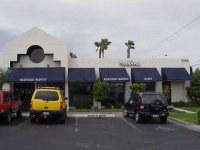

June 11, 2001
Makino is what the label "sushi buffet" implies: a buffet restaurant where you can partake of all the sushi --and other delicacies-- you can eat. And it is all delicious.
 Makino
is located in a free-standing building at 3965 South Decatur, in the Renaissance
West shopping plaza. The plaza is at the northwest corner of Flamingo and Decatur,
just a few minutes' drive west of the Strip on Flamingo, past the Rio and the
Gold Coast hotel-casinos. Because Makino borders on Decatur, the easiest way
to get into the parking lot if driving from the Strip is to turn right from
Flamingo onto Decatur, then immediately turn left into the plaza.
Makino
is located in a free-standing building at 3965 South Decatur, in the Renaissance
West shopping plaza. The plaza is at the northwest corner of Flamingo and Decatur,
just a few minutes' drive west of the Strip on Flamingo, past the Rio and the
Gold Coast hotel-casinos. Because Makino borders on Decatur, the easiest way
to get into the parking lot if driving from the Strip is to turn right from
Flamingo onto Decatur, then immediately turn left into the plaza.
I'll tell you more about Makino shortly, but first let's explore the wonderful world of sushi.
The Oxford English Dictionary defines sushi as "a Japanese dish consisting of small balls of cold rice flavored with vinegar and commonly garnished with slices of fish or cooked egg, or rolled in a piece of laver (nori)," which are thin sheets of dried seaweed.
In fact, "sushi" actually means "vinegar-cured rice," with the raw fish being an add-on. And when the raw fish is served by itself, it is called sashimi, which means "pierced flesh" in Japanese.
While the definition may not sound appetizing to the uninitiated, the joy is in the tasting.
Sushi in its present form came into existence in the eighteenth century. For several centuries before, sushi was primarily a means of preserving fish. Cleaned, raw fish were pressed between layers of salt and weighted with a stone. After a few weeks, the stone was removed and replaced with a light cover, and a few months after that, the fermented fish and rice were ready to eat. This style of sushi, called narezushi, can be found today in some Japanese restaurants, but the strong flavor is an acquired taste that most westerners don't favor.
In the eighteenth century, a chef named Yohei decided to skip the fermentation process and began serving it in a form close to the style most familiar today. Two styles of sushi emerged: Kansai style came out of the city of Osaka, and Edo style came from Tokyo. In Kansai style, the sushi consists mainly of the seasoned rice mixed with other ingredients and formed into edible packages. In Edo style, which is the type we westerners know and love best, the chefs of Tokyo produced nigiri-sushi, meaning "pressed by hand," in which a slice of cooked or uncooked fish lays across a pad of vinegared rice, with the ingredients then gently pressed together.
The bottom line: nigiri-sushi is what you will most commonly find at sushi restaurants in the U.S. and elsewhere, including the sushi establishments of Las Vegas.
The name Makino comes from the Makino brothers, who in 1985 opened their first sushi buffet restaurant in Santa Monica, California. The restaurant was called Lighthouse Seafood Buffet Restaurant. The word for lighthouse in Japanese is pronounced "todai," and as more seafood buffet restaurants opened, they were first named Makino Todai. But in 1997, a group of investors established Todai Franchising LLC, and the outlets are now known as Todai seafood buffet restaurants.
There are currently between 15 and 20 Todai restaurants, mostly in southern California, but also in Texas, Hawaii and Oregon, and also coming to Washington State and Florida. A representative of Todai Franchising, which is based in Los Angeles, told me the company plans to open or franchise four or five restaurants a year for the foreseeable future.
Which brings us to the Makino buffet in Las Vegas, which no longer has Todai in its name. This is because the Las Vegas entity is no longer part of the Todai chain and is now privately owned. Fortunately, however, the original Todai concept has been maintained with little or no change. This means that anyone who has dined in a Todai restaurant is likely to feel very much at home when visiting Las Vegas Makino.
Anyone who has sampled sushi in a typical sushi bar or restaurant knows that it is expensive. A two-piece sushi item can easily cost $8.00 or more, and it is not uncommon for a couple to spend $80 to $100 in satisfaction of their craving.
Makino puts a lid on runaway tabs by offering all you can eat for a fixed price. The focal point of the handsome restaurant, which seats about 200, is the 160-foot-long buffet, which works its way down the left side of the room, then travels across the back wall, and finally doglegs left to go even deeper. As diners make their selections, a large crew of chefs prepare the sushi and sashimi selections while a crew of cooks keep the salads, hot items and desserts from running out.
We've already dined at Makino four times since our first visit several weeks ago. Here's what we found on a typical dinner spread:
 Soups
were miso shiro (soy broth) and noodle soup. Bowls were set out with noodles
and vegetables in the bottom, waiting for diners to pour the aromatic broths
over them.
Soups
were miso shiro (soy broth) and noodle soup. Bowls were set out with noodles
and vegetables in the bottom, waiting for diners to pour the aromatic broths
over them.
Hot dishes included: baked scallops on the half-shell; shrimp and vegetable tempura; chicken and shrimp sauté; grilled salmon; grilled beef on skewers; stuffed mushrooms; jumbo shrimp, butterflied with a cheese topping; bacon roll with asparagus; barbecued pork skewers; fried oysters; fried soft noodles; barbecued chicken; fried rice.
Cold dishes and salads: snow crab legs; small, peeled cocktail shrimp; oysters on the half-shell; black seaweed salad; green seaweed salad; potato salad; seafood mix (octopus and squid); green-lip mussels; oyster meats; raw tuna salad (fantastic!); eel and egg; tataki bonito; Caesar salad; radish coleslaw; roasted eggplant with peppers.
Rolls (mostly wrapped in nori): tempura roll; tekka-maki (nori-wrapped tuna roll); tuna roll with spicy mayo; avocado roll; kappa-maki (cucumber filled maki-zushi); kanpyo roll (pickled gourd); spicy shrimp; chopped clam; masago (smelt roe); asari baby clam; spicy shrimp; eel; ikura (salmon); futo-maki (fat roll); California roll; rainbow roll.
Sushi: saba (mackerel); herring; mirugai (jumbo clam); ebi (shrimp); tako (octopus); sake (salmon); tai (red snapper); ika (squid); toro (fatty tuna); tamago (egg custard); avocado; inari (tofu pouches); temaki (salmon skin); unagi (eel); hamachi (yellowtail); maguro (tuna).
Sashimi: octopus; salmon; tuna; yellowtail.
Though the raw seafood items are placed on trays from which diners serve themselves, we have found all the selections to be fresh and tasty. The sushi chefs work constantly to keep the selections from running out, and none of them sit long enough to cause a health risk.
Desserts: watermelon; cantaloupe; red and green seedless grapes; cherries; fruit Jello; creme brulee; cream-cheese pastries; chocolate mousse; mango delight; cream puffs; cocktail fruits in syrup; almond, sesame and chocolate-chip cookies.
As you can see, there is much more at Makino than just sushi, making it an attractive option for those who don't care for sushi but are accompanying someone who does.
Makino is open for lunch and dinner seven days a week. Lunch hours are 11:30 a.m. to 2:30 p.m. Monday through Thursday, and 11:30 a.m. to 3:00 p.m. Friday through Sunday. Dinner hours are 5:30 p.m. to 9:30 p.m. each evening.
The restaurant has an interesting price structure, especially for children. Lunch each day is $12.95, while dinner is $20.95 Monday through Thursday and $21.95 Friday through Sunday. Babies who can't stand on their own eat free. Children who are under 12 years old and three feet or shorter in height are charged $2.50 at lunch and dinner; those between three feet and four feet tall are charged $4.95 at lunch and $5.95 at dinner; those between four and five feet tall are charged half the adult price. Seniors age 65 and over, with a valid I.D., get a 20-percent discount at dinner.
The price differential between lunch and dinner makes lunch at Makino an especially good deal. Some of the higher-end items served at dinner, such as the oysters on the half-shell, crab legs and cooked shrimp, are not offered at lunch, but almost all the Japanese hand rolls and sushi selections are available. So if you are not sure how you will take to sushi, you can save by trying the place for lunch.
The restaurant serves alcoholic beverages, including sake. Non-alcoholic beverages, such as soft drinks and iced tea, cost $1.50 with unlimited refills. As befits a facility where freshly prepared food is displayed in a large, open room, Makino is a no-smoking restaurant. Major credit cards are accepted, and Makino's phone number is (702) 889-4477.
Those who prefer their all-you-can-eat sushi and other Japanese specialties made to order from a menu will do well to try the superb Sushi On Rainbow and Sushi On Tropicana restaurants. But when it comes to a real buffet where you can satisfy your sushi Jones, Makino is the only game in town. And a wonderful game it is.
If you'd like to learn more about sushi, here are links to several Web sites
featuring definitions and terminology:
http://www.wcnet.org/~kralizec/sushi/s-glossary.html
http://www.learn-food-drink.com/japanese-food/glossary.html
http://www.bento.com/sushivoc.html
The About.com Web site offers some excellent Japanese-cuisine information,
courtesy of About Guide Setsuko Yoshizuka:
http://japanesefood.about.com/food/japanesefood/mbody.htm
--Best from David in NV